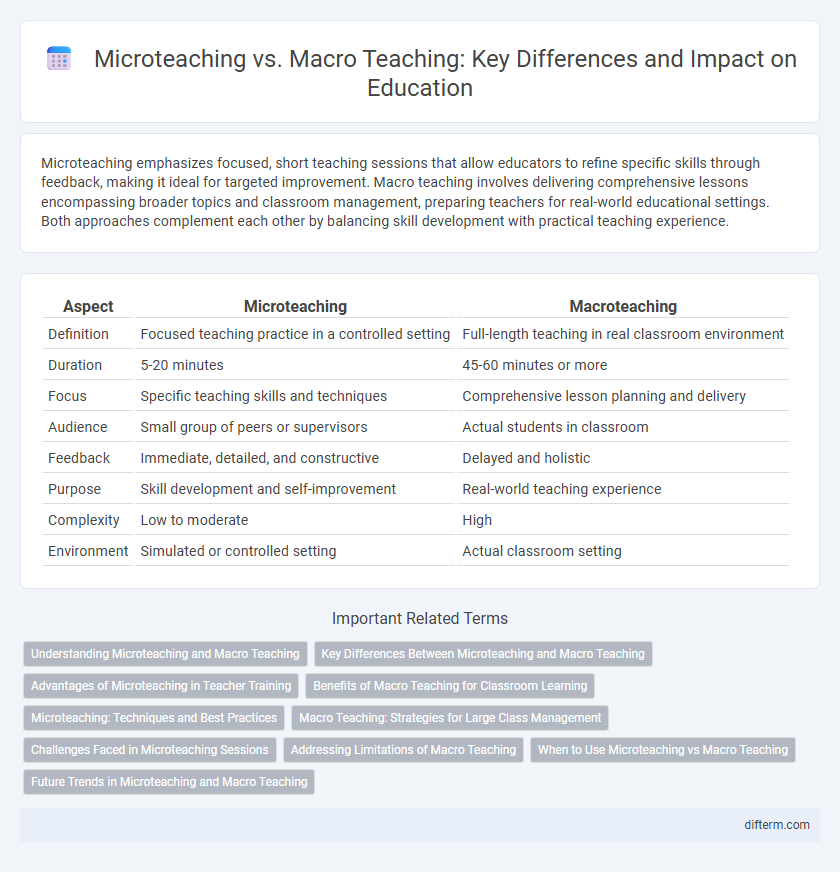Microteaching emphasizes focused, short teaching sessions that allow educators to refine specific skills through feedback, making it ideal for targeted improvement. Macro teaching involves delivering comprehensive lessons encompassing broader topics and classroom management, preparing teachers for real-world educational settings. Both approaches complement each other by balancing skill development with practical teaching experience.
Table of Comparison
| Aspect | Microteaching | Macroteaching |
|---|---|---|
| Definition | Focused teaching practice in a controlled setting | Full-length teaching in real classroom environment |
| Duration | 5-20 minutes | 45-60 minutes or more |
| Focus | Specific teaching skills and techniques | Comprehensive lesson planning and delivery |
| Audience | Small group of peers or supervisors | Actual students in classroom |
| Feedback | Immediate, detailed, and constructive | Delayed and holistic |
| Purpose | Skill development and self-improvement | Real-world teaching experience |
| Complexity | Low to moderate | High |
| Environment | Simulated or controlled setting | Actual classroom setting |
Understanding Microteaching and Macro Teaching
Microteaching involves teaching a short lesson to a small group or peers, emphasizing skill development, feedback, and self-reflection, making it ideal for practice in controlled settings. Macro teaching refers to delivering full-length lessons to larger, diverse classrooms, focusing on comprehensive planning, classroom management, and real-time adaptability. Both approaches are crucial in teacher training, with microteaching refining specific techniques and macro teaching developing overall instructional competence.
Key Differences Between Microteaching and Macro Teaching
Microteaching involves short, focused teaching sessions typically lasting 5 to 10 minutes, designed for skill development and immediate feedback in a controlled environment, whereas macro teaching encompasses full-length lessons or courses targeting broader instructional goals. Microteaching allows for concentrated practice of specific teaching techniques with fewer students, while macro teaching deals with larger class sizes and integrates comprehensive curriculum delivery. Key differences include scope, duration, student numbers, and objectives, with microteaching emphasizing skill refinement and macro teaching emphasizing content mastery and classroom management.
Advantages of Microteaching in Teacher Training
Microteaching offers significant advantages in teacher training by enabling focused practice on specific teaching skills in a controlled environment, leading to enhanced instructional effectiveness. It allows for immediate, targeted feedback and reflection, which accelerates skill development and builds teacher confidence. This iterative process facilitates mastery of concise teaching segments before facing full classroom challenges, improving overall teaching quality.
Benefits of Macro Teaching for Classroom Learning
Macro teaching enhances classroom learning by providing comprehensive exposure to entire lessons, enabling students to grasp complex concepts in context. It allows for continuous assessment and feedback, fostering deeper understanding and skill application. This approach also cultivates classroom management skills and real-time interaction, which are essential for effective teaching and student engagement.
Microteaching: Techniques and Best Practices
Microteaching emphasizes focused, short teaching sessions designed to refine specific instructional skills through practice and feedback. Techniques such as video recording, peer observation, and targeted question formulation enable educators to analyze and improve lesson delivery efficiently. Best practices include setting clear objectives, using concise lesson segments, and engaging in reflective discussions to enhance teaching effectiveness.
Macro Teaching: Strategies for Large Class Management
Macro teaching employs strategies tailored for effective large class management, emphasizing structured lesson planning, clear communication, and active student engagement. Techniques such as group discussions, multimedia integration, and formative assessments facilitate maintaining attention and enhancing comprehension across diverse learner groups. Classroom layout optimization and classroom management protocols also contribute to minimizing distractions and fostering an inclusive learning environment.
Challenges Faced in Microteaching Sessions
Microteaching sessions often face challenges such as limited time constraints, which restrict in-depth exploration of topics and reduce opportunities for real-time feedback. The controlled environment may induce anxiety among trainee teachers, impacting their performance and natural teaching style. Additionally, the artificial setting makes it difficult to replicate diverse classroom dynamics and student behaviors encountered in macro teaching.
Addressing Limitations of Macro Teaching
Microteaching addresses the limitations of macro teaching by providing a controlled environment where educators can practice specific teaching skills with smaller groups and receive focused feedback. This method enhances teacher confidence and competence by allowing targeted improvements before handling full classroom dynamics in macro teaching. Reduced scale and time commitment in microteaching facilitate iterative skill refinement, overcoming the challenges of broader lesson execution inherent in macro teaching.
When to Use Microteaching vs Macro Teaching
Microteaching is most effective during the early stages of teacher training, allowing educators to practice and refine specific teaching skills in a controlled, low-stress environment. Macro teaching is suitable for advanced learners or in professional settings where teachers manage full-length lessons and entire classroom dynamics. Choosing microteaching focuses on skill development and immediate feedback, while macro teaching emphasizes comprehensive lesson delivery and classroom management over extended periods.
Future Trends in Microteaching and Macro Teaching
Future trends in microteaching emphasize the integration of virtual reality and AI-driven analytics to provide personalized feedback and immersive practice environments. Macro teaching is evolving with the adoption of hybrid classroom models and advanced learning management systems that enhance interactive and large-scale instructional delivery. Both micro and macro teaching methodologies increasingly leverage data analytics to optimize student engagement and learning outcomes.
microteaching vs macro teaching Infographic

 difterm.com
difterm.com